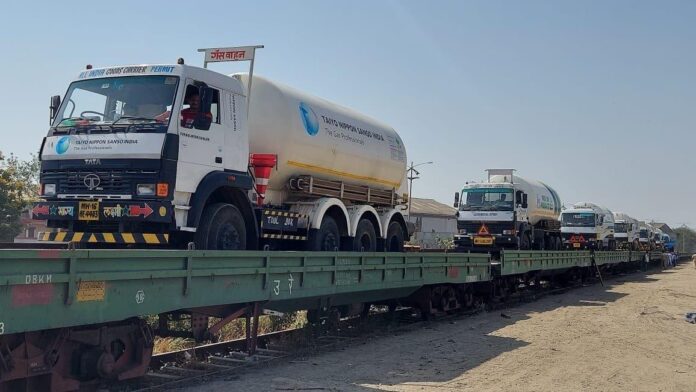INDIAN government representatives from several ministries and departments in New Delhi on Monday presented the following information about how they are dealing with the COVID-19 pandemic in the country:
- Of the total cases currently, 81.77% have recovered
- 1% are active and the cumulative fatality is 1.1%.
- Even if we consider the last 2-3 months, the death rate has been below 1%.
- Latest analysis of daily cases and deaths show certain positive developments:
The number of cases have been decreasing consecutively for last two days from over 400,000 to 368,000. This trajectory is visible in deaths as well. However, these are very early signs and continuous monitoring is going on.
- There are some causes of concern which would require extra effort. There are 12 states which have more than 100,000 active cases and 7 states have active cases between 50,000 to 100,000. [India has 28 states and 8 union territories.]
- Sample case positivity of states:
22 states have positivity rate more than 15%,
9 states have between 5 and 15% and
5 states have less than 5%.
- Early signs of plateauing are visible in some states. Some of these are Chhattisgarh (15,500 to 14,900 cases), Delhi (25,200 to 24,000), Madhya Pradesh (13,000 to 12,800). Plateauing is also visible in Jharkhand, Punjab and Telangana. Early stages of plateauing is also visible in Uttar Pradesh and Uttarakhand. Reduction in cases is also visible at the district level. In Maharashtra, there are 12 districts which have seen reduced cases. However, these are early stages and continued efforts of containment need to be maintained to ensure early gains are preserved.
- At the same time there are states which are seeing an increasing number of daily cases like Andhra Pradesh, Assam, Bihar, Karnataka and Kerala, Chandigarh, Haryana and Himachal Pradesh. It is important for these states to focus on containment and micro level analysis
Vaccines and recoveries (positive trend)
- How many have been vaccinated so far:
15.70 million Healthcare workers
20.60 million Frontline workers,
120.70 million above 45 years.
- Vaccinations for those between 18-44 years have just begun with about 180,000 vaccinated so far.
- Daily recoveries have begun to see a positive trend. While on 20th April there were 2,59,000 cases against 1,54,000 recoveries, which implies 60% active cases were being added on a daily basis. On 30th April there were 77% recoveries, 2nd May 78% and on 3rd May 82%.
Other positive efforts underway by the government:
- Use of gaseous oxygen for medical use is being planned.
- Next to those industrial units which are making oxygen suitable for medical purpose and which are in close proximity to towns, temporary COVID-19 centres will be set up. Work on 5 facilities has already begun. The plan is to increase these to 10,000 oxygenated beds
- There are 1,500 oxygen PSA plants which are being developed in an expedited manner.
- Nitrogen PSA plants are being converted to oxygen PSA plants to supplement the production of oxygen. 14 Industries have been identified for this purpose. 37 PSA units have been identified among these industries for this purpose. The government is considering either to make temporary hospitals around these or try to shift these plants to hospitals
- In order to reinforce human resources medical entrance (NEET) and PG exams are being postponed by 4 months. Medical interns are channelled towards COVID-19 care as part of their internship and Final Year MBBS students will be utilized for tele-consultation and monitoring of mild COVID-19 cases under the supervision of faculty.
- Final year PG students will continue their residency until replenished by the fresh batch. Qualified nurses are being utilized in full-time COVID-19 nursing duties under the supervision of senior doctors and nurses. Allied health professionals based on training are going to complement the medical personnel.
- Those medical personnel who complete 100 days of COVID-19 duties will be given Prime Minister’s Distinguished Covid National Service Samman and will be given priority in medical recruitments.
- Medical students and healthcare professions will be supported through vaccine and insurance.
- States with vacant medical positions of doctors, nurses or allied staff have been asked to fill the positions through and accelerated process within 45 days
Management of cases
- To prevent increase in infections a supply side approach (hospitals, medical resources) is being pursued. It is important to focus on demand side management as well, to break the chain of transmission.
- Ministry of Home Affairs has issued guidelines under Disaster Management Act and have reiterated guidelines of the Ministry of Health and Family Welfare, that all states should identify districts of concern, where positivity is higher than 10% or where ICUs / oxygen catered beds have been filled to 60% capacity. States have been requested to identify districts where cluster of cases exist and take local containment measures to reduce mingling of people and follow efforts in lines with epidemiological situation. Intensive actions in these cases should focus on containment and ban on non-essential congregations and gathering, essential services continued focus on testing and surveillance, special teams on containment.
- The health infrastructure is being continuously upgraded and steps are being taken to ensure information about hospital bed availability is available in public domain.
- Efforts are constantly underway to reduce misinformation and panic and focus on COVID-19 appropriate behaviour.
What has been achieved so far
- Daily production of Oxygen has increased from 5,700 MT on 1 August 1, 2020, to 9,000 MT currently. Oxygen sales are at the level 7,500-8,000 MT.
- In order to reduce the turn-around time, government has decided that empty tankers will be transported by the Air Force to the place of production to be filled. Tankers with oxygen are being sent out to the cities across India by “Oxygen Express” – special trains by the Indian Railway.
- Supply is being continuously monitored and developed keeping in mind the needs of the States.
- Based on the suggestion of the Central Government and with the aim of increasing the number of tankers, State Governments have made positive strides in converting 50% of nitrogen and argon tankers to oxygen tankers. Tankers from abroad are being purchased, hired. Local production of tankers in India is also being ramped up.
- Ministry of Health and Family Welfare in coordination with the states have developed and are deploying real time GPS tagging systems on these tankers. This ensures effective tracking and prevent diversions or unauthorized stops.











